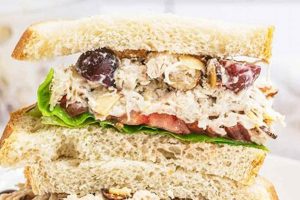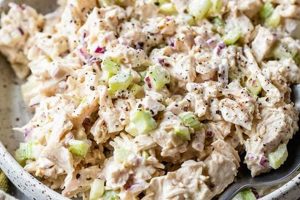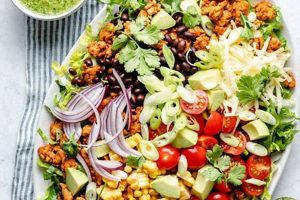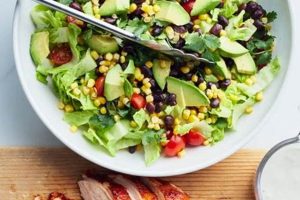Wraps filled with chicken salad offer a convenient and customizable meal option. A focus on healthful ingredients, such as lean protein, whole grains, and fresh produce, transforms this simple dish into a nutritious choice. For example, using grilled chicken breast, Greek yogurt instead of mayonnaise, and whole-wheat tortillas increases the nutritional value compared to versions using fried chicken, full-fat mayonnaise, and refined-grain tortillas.
Nutritious chicken salad wraps offer numerous advantages. They provide a balanced source of protein, complex carbohydrates, and healthy fats, contributing to satiety and sustained energy levels. Incorporating fresh vegetables adds essential vitamins, minerals, and dietary fiber. Historically, chicken salad emerged as a popular luncheon dish in the late 19th century, evolving alongside changing culinary trends. The increasing emphasis on health and wellness in recent decades has led to a demand for lighter, more nutritious versions of this classic.
This article will explore various strategies for creating healthy chicken salad wraps, including ingredient selection, preparation techniques, and creative variations to enhance flavor and nutritional value. It will also address portion control, storage, and meal planning tips to incorporate these wraps into a balanced diet.
Tips for Creating Healthy Chicken Salad Wraps
The following tips offer guidance on preparing nutritious and flavorful chicken salad wraps.
Tip 1: Prioritize Lean Protein: Opt for lean protein sources such as grilled, baked, or poached chicken breast. Removing skin and visible fat further reduces caloric content and saturated fat.
Tip 2: Reimagine the Base: Instead of relying solely on mayonnaise, consider incorporating Greek yogurt, avocado, or hummus. These alternatives contribute creaminess while boosting nutritional value with healthy fats, protein, and fiber.
Tip 3: Embrace Whole Grains: Choose whole-wheat tortillas or wraps for added fiber and complex carbohydrates, promoting satiety and digestive health.
Tip 4: Maximize Fresh Produce: Incorporate a variety of chopped vegetables, such as celery, bell peppers, onions, and leafy greens. These additions contribute essential vitamins, minerals, and texture.
Tip 5: Enhance Flavor Strategically: Utilize fresh herbs, spices, and citrus juices to enhance flavor profiles without resorting to excessive salt or sugar. Consider adding Dijon mustard, chopped grapes, or dried cranberries for bursts of flavor.
Tip 6: Practice Portion Control: Be mindful of portion sizes to manage calorie intake effectively. Using smaller tortillas or dividing larger wraps into halves can assist with portion control.
By following these tips, individuals can create flavorful and nutritious chicken salad wraps that contribute to a balanced diet and promote overall well-being.
These practical strategies offer a foundation for incorporating healthy chicken salad wraps into a balanced dietary plan.
1. Lean Protein Sources
Lean protein sources play a crucial role in creating a truly healthy chicken salad wrap. Protein contributes to satiety, supports muscle maintenance and growth, and provides essential amino acids. Choosing lean options minimizes unhealthy fats and calories, aligning with the health-focused objective of the recipe.
- Chicken Breast:
Chicken breast stands out as a quintessential lean protein choice for chicken salad. Skinless, boneless chicken breast provides a significant amount of protein with minimal fat. Grilling, baking, or poaching are preferred cooking methods to minimize added fats compared to frying. This approach ensures the chicken salad remains a healthy and satisfying meal component.
- Turkey Breast:
Turkey breast offers a lean alternative to chicken, providing a slightly different flavor profile. Ground turkey can also be utilized, although it is important to select lean ground turkey and drain excess fat after cooking. This option provides flexibility in texture and taste while maintaining the health-conscious focus.
- Canned Tuna (in Water):
Canned tuna packed in water provides a convenient and affordable lean protein source. Draining the water thoroughly removes excess sodium. Opting for tuna packed in water rather than oil significantly reduces fat content, further contributing to a healthier chicken salad.
- Plant-Based Options (e.g., chickpeas, lentils):
For vegetarian or vegan variations, chickpeas or lentils can be incorporated as protein sources. These legumes also contribute fiber and complex carbohydrates, enhancing the nutritional profile of the chicken salad. Their inclusion offers a plant-based approach to creating a satisfying and healthy wrap.
The selection of lean protein forms the foundation of a healthy chicken salad wrap. By prioritizing these options, the dish provides essential nutrients without excessive calories or unhealthy fats. This emphasis on lean protein contributes significantly to achieving a balanced and nutritious meal, aligning with the overall health-conscious goal of the recipe.
2. Whole-grain wraps
Whole-grain wraps play a crucial role in enhancing the nutritional value of a healthy chicken salad wrap. Compared to refined-grain options, whole-grain wraps offer increased fiber content, contributing to digestive health and promoting satiety. This choice aligns with the objective of creating a nutritious and satisfying meal.
- Fiber Content:
Whole-grain wraps provide significantly more dietary fiber than wraps made from refined grains. Fiber plays a vital role in digestive health, promoting regularity and preventing constipation. It also contributes to feelings of fullness, which can assist with weight management by reducing overall calorie intake. In the context of a healthy chicken salad wrap, the added fiber complements the other nutritious ingredients, creating a meal that supports digestive well-being.
- Nutrient Density:
Whole grains retain the bran and germ layers of the grain kernel, which contain essential vitamins, minerals, and antioxidants. Refined grains lack these components, resulting in a less nutrient-dense product. Choosing whole-grain wraps for a chicken salad wrap increases the overall nutrient content of the meal, contributing to a more balanced and healthful diet.
- Glycemic Index:
Whole-grain wraps typically have a lower glycemic index (GI) than refined-grain wraps. This means they cause a slower and more gradual rise in blood sugar levels, preventing energy crashes and reducing the risk of chronic diseases like type 2 diabetes. In a healthy chicken salad wrap, this stable blood sugar response contributes to sustained energy levels and overall metabolic health.
- Variety and Availability:
Whole-grain wraps are readily available in various forms, including whole-wheat, multigrain, and sprouted grain varieties. This variety allows for customization and caters to different taste preferences. The widespread availability of whole-grain wraps makes it easy to incorporate them into a healthy chicken salad wrap recipe, enhancing both convenience and nutritional value.
The selection of a whole-grain wrap significantly contributes to the overall healthfulness of a chicken salad wrap. The increased fiber, nutrient density, and lower glycemic index align with the goals of creating a meal that supports both immediate and long-term well-being. This choice enhances the nutritional profile of the wrap, moving beyond mere convenience to provide a foundation for a truly healthy and satisfying meal.
3. Reduced-Fat Ingredients
Reduced-fat ingredients are fundamental to achieving a truly healthy chicken salad wrap. Lowering fat content, particularly saturated and trans fats, contributes significantly to overall health by reducing caloric intake and promoting cardiovascular well-being. This approach aligns seamlessly with the health-conscious objective of the recipe.
- Greek Yogurt:
Greek yogurt presents a versatile alternative to traditional mayonnaise. Its higher protein content contributes to satiety, while its lower fat content aligns with the health-focused objective. Greek yogurt provides a creamy texture and tangy flavor that complements chicken salad effectively. For instance, substituting Greek yogurt for half or all of the mayonnaise significantly reduces overall fat and calories without sacrificing flavor or texture.
- Avocado:
Avocado offers healthy monounsaturated fats, contributing to satiety and providing essential nutrients. While not a “reduced-fat” ingredient in the strictest sense, avocado replaces less healthy fats found in traditional mayonnaise-based chicken salads. Its creamy texture enhances the wrap’s palatability. Using a moderate amount of avocado provides healthy fats and contributes to a satisfying and nutritious meal.
- Reduced-Fat Mayonnaise:
When mayonnaise is preferred, opting for a reduced-fat version offers a compromise. While not as low in fat as Greek yogurt or avocado, reduced-fat mayonnaise still significantly decreases fat content compared to full-fat versions. This option allows for a more traditional chicken salad flavor profile while still adhering to the health-conscious principle of reducing overall fat intake. Careful portion control remains essential when using even reduced-fat mayonnaise.
- Light or Fat-Free Cheese:
If cheese is desired in the chicken salad wrap, selecting light or fat-free varieties minimizes added fat and calories. These options maintain the flavor and texture of cheese while aligning with the recipe’s health-focused approach. For example, using shredded reduced-fat cheddar cheese adds flavor and protein without significantly increasing fat content, contributing to a balanced and nutritious meal.
The strategic use of reduced-fat ingredients transforms a classic chicken salad wrap into a genuinely healthy option. By incorporating these alternatives, the recipe significantly reduces overall fat and calorie content without compromising flavor or satisfaction. This approach underscores the importance of ingredient selection in achieving a balanced and nutritious meal that aligns with health-conscious dietary goals.
4. Fresh Vegetables
Fresh vegetables are essential for a genuinely healthy chicken salad wrap, contributing significantly to nutritional value and overall palatability. Their inclusion elevates the wrap from a simple convenience food to a nutrient-rich meal. The inherent vitamins, minerals, antioxidants, and dietary fiber in fresh vegetables directly address key dietary requirements often lacking in processed foods. This nutritional boost aligns with the core objective of a “healthy” recipe designation.
The impact of incorporating fresh vegetables extends beyond basic nutrition. Increased fiber content aids digestion and promotes satiety, contributing to weight management goals. The water content in many vegetables, such as cucumbers and celery, adds volume and hydration without extra calories. Furthermore, the diverse flavors and textures of vegetables enhance the sensory experience of the wrap, reducing the need for excessive salt or unhealthy flavor enhancers. For example, the crispness of celery and bell peppers contrasts with the creaminess of the chicken salad, creating a more complex and satisfying meal. Adding spinach or romaine lettuce provides a mild, leafy counterpoint while boosting vitamin and mineral intake. The vibrant colors of chopped carrots, red onion, or bell peppers visually enhance the appeal of the wrap.
Understanding the vital role of fresh vegetables in creating a truly healthy chicken salad wrap allows for informed choices that maximize nutritional benefits. Prioritizing a variety of colorful vegetables ensures a broader spectrum of nutrients. Proper storage and preparation techniques maintain optimal freshness and prevent nutrient loss. Incorporating fresh vegetables not only enhances the nutritional profile of the wrap but also elevates its overall quality and enjoyment. This practical application of nutritional knowledge transforms the chicken salad wrap from a convenient snack into a health-conscious meal choice.
5. Mindful Portion Sizes
Portion control plays a critical role in maintaining a healthy diet, even with nutritious meals like chicken salad wraps. While focusing on healthy ingredients contributes significantly to overall nutritional value, consuming excessive quantities can negate these benefits. Calorie control remains essential for weight management and overall health. A chicken salad wrap, even when made with lean protein, whole grains, and fresh vegetables, still contains calories. Overconsumption can lead to weight gain and potentially contribute to other health issues. Therefore, mindful portion sizes are indispensable for aligning the wrap with health goals. For example, a large wrap overflowing with chicken salad, even a healthy version, can easily exceed recommended calorie targets for a single meal. Conversely, a smaller wrap with a balanced filling allows for enjoyment and satisfaction while adhering to portion control principles.
Practical strategies for managing portion sizes include using smaller tortillas or dividing a larger wrap in half. Pre-portioning ingredients during preparation facilitates controlled assembly and prevents overfilling. Pairing the wrap with a side of nutrient-rich, low-calorie foods, such as a small salad or a serving of fruit, enhances satiety without significantly increasing caloric intake. Understanding serving sizes and recommended daily allowances for various food groups provides a framework for informed decision-making. This knowledge empowers individuals to tailor portion sizes to individual needs and dietary goals. For instance, an athlete with higher caloric needs may require a larger wrap than a sedentary individual. Recognizing these individual variations emphasizes the importance of personalized portion control.
Mindful portion sizes are integral to the concept of a “healthy” chicken salad wrap recipe. While ingredient selection lays the foundation for nutritional value, portion control ensures that this value translates into practical health benefits. Integrating portion control strategies into meal planning and preparation empowers individuals to consume nutritious foods, like chicken salad wraps, in a manner that supports overall health and well-being. This holistic approach moves beyond simply creating a healthy recipe to fostering a healthy eating pattern.
Frequently Asked Questions
This section addresses common inquiries regarding healthy chicken salad wrap recipes, providing concise and informative responses.
Question 1: How can sodium content be minimized in a healthy chicken salad wrap?
Sodium content can be minimized by using fresh chicken breast rather than pre-packaged or deli chicken, rinsing canned beans thoroughly, choosing low-sodium condiments, and avoiding added salt during preparation. Fresh herbs and spices can be used to enhance flavor without increasing sodium.
Question 2: What are suitable alternatives to tortillas for a gluten-free option?
Lettuce cups, collard green leaves, or gluten-free wraps or tortillas provide suitable alternatives for those seeking to avoid gluten. These options maintain the wrap format while catering to specific dietary needs.
Question 3: How can chicken salad wraps be incorporated into a weight-management plan?
Chicken salad wraps can support weight management by prioritizing lean protein, whole grains, and fresh vegetables. Portion control is crucial. Tracking calorie intake and balancing the wrap with other healthy meals and snacks throughout the day contributes to effective weight management.
Question 4: How long can chicken salad be safely stored in the refrigerator?
Prepared chicken salad should be stored in an airtight container in the refrigerator for no more than 3-5 days. Proper refrigeration prevents bacterial growth and maintains food safety.
Question 5: Can chicken salad wraps be frozen?
While freezing is possible, the texture of some ingredients, such as mayonnaise and fresh vegetables, may be negatively affected upon thawing. Freezing the chicken salad separately and assembling the wraps fresh after thawing is generally recommended for optimal quality.
Question 6: How can one ensure a balance of nutrients in a chicken salad wrap?
Nutrient balance is achieved by incorporating lean protein, complex carbohydrates from whole grains, healthy fats from sources like avocado or nuts, and a variety of fresh vegetables for essential vitamins and minerals. This combination contributes to a well-rounded and nutritious meal.
Addressing these common inquiries provides a comprehensive understanding of healthy chicken salad wrap recipes, facilitating informed choices that support individual dietary needs and preferences.
The subsequent sections will provide specific recipe examples and further explore variations for customization and dietary adaptations.
Chicken Salad Wrap Recipe Healthy
Exploration of “chicken salad wrap recipe healthy” reveals the potential for transforming a convenient meal into a nutritious dietary component. Prioritizing lean protein sources, such as grilled chicken breast, contributes to satiety and muscle maintenance. Incorporating whole-grain wraps increases fiber intake, supporting digestive health. Substituting Greek yogurt for mayonnaise, or using reduced-fat mayonnaise, lowers overall fat content. The inclusion of fresh vegetables provides essential vitamins, minerals, and antioxidants. Finally, mindful portion control ensures that caloric intake aligns with health goals. Each element contributes synergistically to a balanced and nutritious meal.
Shifting dietary patterns toward healthier choices requires thoughtful consideration of ingredients and preparation methods. Chicken salad wraps, when thoughtfully constructed, exemplify this principle. The discussed strategies offer a framework for creating meals that nourish the body while satisfying individual preferences. Continued exploration of healthy recipe adaptations empowers individuals to make informed food choices that support long-term well-being. This proactive approach to nutrition emphasizes the profound impact of dietary choices on overall health outcomes.






